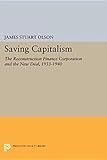Saving Capitalism : The Reconstruction Finance Corporation and the New Deal, 1933-1940 / James Stuart Olson.
Material type: TextSeries: Princeton Legacy Library ; 5037Publisher: Princeton, NJ : Princeton University Press, [2017]Copyright date: ©1988Description: 1 online resource (258 p.)Content type:
TextSeries: Princeton Legacy Library ; 5037Publisher: Princeton, NJ : Princeton University Press, [2017]Copyright date: ©1988Description: 1 online resource (258 p.)Content type: - 9781400886944
- 353.0082/509 23
- online - DeGruyter
| Item type | Current library | Call number | URL | Status | Notes | Barcode | |
|---|---|---|---|---|---|---|---|
 eBook
eBook
|
Biblioteca "Angelicum" Pont. Univ. S.Tommaso d'Aquino Nuvola online | online - DeGruyter (Browse shelf(Opens below)) | Online access | Not for loan (Accesso limitato) | Accesso per gli utenti autorizzati / Access for authorized users | (dgr)9781400886944 |
Frontmatter -- Contents -- Acknowledgments -- Abbreviations Used in Notes -- CHAPTER I. The Origins of the Reconstruction Finance Corporation -- CHAPTER II. The Emergency Banking Act of 1933 -- CHAPTER III. Czar: Jesse Jones and His Empire -- CHAPTER IV. Reconstruction of the Banking System, 1933–1934 -- CHAPTER V. The New Deal Credit Revolution, 1933–1934 -- CHAPTER VI. The Emergence of a Financial Power, 1933–1935 -- CHAPTER VII. The RFC and the National Recovery Administration, 1933–1935 -- CHAPTER VIII. Decline -- CHAPTER IX. Revival -- CHAPTER X. War and Transformation -- Selected Bibliography -- Index
restricted access online access with authorization star
http://purl.org/coar/access_right/c_16ec
For two generations historians have debated the significance of the New Deal, arguing about what it tried and tried not to do, whether it was radical or reactionary, and what its origins were. They have emphasized the National Recovery Administration, Agricultural Adjustment Administration, Tennessee Valley Authority, or the various social and labor legislation to illustrate an assortment of arguments about the "real" New Deal. Here James Olson contends that the little-studied Reconstruction Finance Corporation was the major New Deal agency, even though it was the product of the Hoover Administration. Pouring more than ten billion dollars into private businesses during the 1930s in a strenuous effort to "save capitalism," the RFC was the largest, most powerful, and most influential of all New Deal agencies, proving that the main thrust of the New Deal was state capitalism--the use of the federal government to shore up private property and the status quo. As national and international money markets collapsed in 1930, Hoover created an RFC with a structure similar to that of his War Finance Corporation. The agency was given two billion dollars to make low-interest loans to commercial banks, savings banks, other financial institutions, and railroads. With modifications, it survived the ultimate collapse of the economy in 1933 and went on to become the central part of the New Deal's effort to preserve fundamental American institutions.Originally published in 1988.The Princeton Legacy Library uses the latest print-on-demand technology to again make available previously out-of-print books from the distinguished backlist of Princeton University Press. These editions preserve the original texts of these important books while presenting them in durable paperback and hardcover editions. The goal of the Princeton Legacy Library is to vastly increase access to the rich scholarly heritage found in the thousands of books published by Princeton University Press since its founding in 1905.
Mode of access: Internet via World Wide Web.
In English.
Description based on online resource; title from PDF title page (publisher's Web site, viewed 24. Aug 2021)


